|
|
Post by groundhog on May 16, 2013 11:38:54 GMT
George Brady
Cardenas, Cuba
11th May 1898 On the other side of Cuba on 11th May 1898 a small US Navy squadron was in action at Cardenas Bay. Two torpedo boats, two gun boats and a Coast Guard cutter entered the bay to destroy three Spanish ships reported to be there. USS Winslow sailed close to shore to investigate a ship moored there. About 1.30 pm she was fired on and an action ensued that lasted about 90 minutes. USS Winslow sustained heavy damage and had to be towed back out to sea. Several of her crew were killed and wounded and after the battle command fell to Chief Gunner's Mate George Brady who was awarded the Medal ofHonor for his part in the action. Brady was born in Ireland on 7th September 1867. He joined the US Navy in 1884 and was Chief Gunner's Mate aboard the USS Winslow during the Spanish-American War. He received his MOH on 3rd September 1899, his citation reading that he was; “Conspicuously gallant during this period, Brady, by his energy in assisting to sustain fire, his efforts to repair the steering gear and his promptness in maintaining watertight integrity, was largely instrumental in saving the vessel.”George Brady committed suicide aboard the USS Monogahela on 6th November 1903 and is buried I Island Cemetery, Newport, Rhode Island.
|
|
|
|
Post by groundhog on May 18, 2013 11:05:39 GMT
Spotslvania Courthouse, Virginia
12th May 1864 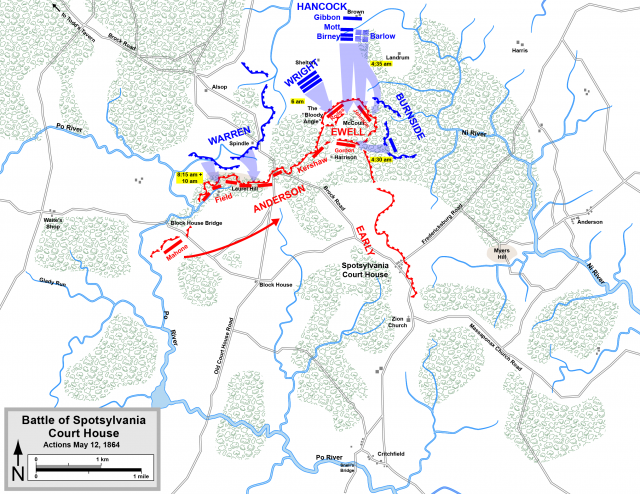 The Battle of Spotslvania Courthouse was part of Grant’s Overland Campaign of 1864 and followed on from the Battle of the Wilderness earlier in May. Spotslvania went on for almost two weeks but the bloodiest day of fighting occurred on 12th May 1864 with a Union assault on Confederate defensive works around a crossroads at Spotslvania Courthouse. The Confederate line formed a salient which was called the Mule Shoe, which was the focus of the Union attack. The assault was to begin at 4 am but was delayed until 4.35 while the morning grew a little brighter. Hancock’s II Coprs advanced against the tip of the Mule Shoe. The five Irish Medal of Honor winners of the day were all in Hancock’s Corps, three of them in Barlow’s 1st Division. Barlow’s Division swung left on it’s advance to attack the east side of the tip of the Mule Shoe. They quickly overcame Stueart’s Brigade here, capturing both Stueart and his divisional commander, Johnson. The three Medal of Honor winners in 1st Division were Private Michael Burk of Company D, 125th New York Infantry; Corporal Alexander McHale of Company H, 26th Michigan Infantry and Private Thomas Robinson of Company H, 81st Pennsylvania Infantry. Michael Burk  Burk was born in Ireland in 1844, joining the army in Troy, New York. He was wounded in the chest while capturing a Confederate flag as he advanced over the Confederate defensive works and was awarded the Medal of Honor on 1st December 1864. He died in Troy on 3rd February 1878 and is bured in St. Mary’s Cemetery. His headstone bears his proper name of Burke. Alexander McHale 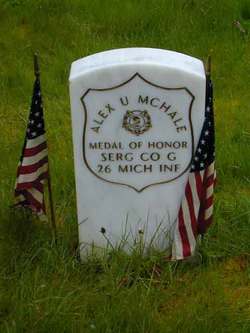 Alexander McHale was born in 1842 and joined the army in Muskegon, Michigan. His medal was issued on 11th January 1900 for the capture of a Confederate colour. McHale died in Orting, Washington on 13th March 1911 and is buried in Washington Soldiers Home Cemetery. Thomas Robinson Very little is known about Thomas Robinson. He entered service at: Tamaqua, Pennsylvania. Birth and was issued his medal on 1st December 1864 for the capture of a flag in a hand_to_hand conflict. His dates of birth and death are unknown. After Barlow’s initial success and that of Birney’s Division on his right, the Confederates rushed reinforcements forward and stopped the advance of II Corps, in which massive confusion now reigned with 15,000 men crammed in a half mile front. At 6.30 am Grant committed two more Corps to the western flank of the Mule Shoe. To add to the troops difficulties it began to rain at 8 am. The attacks on the western flank failed to draw Confederate troops from the tip of the Mule Shoe and the fighting became a slogging match as Confederate Engineers began building a new defensive line at the base of the salient. The Confederates began to with draw at 4am on the 13th leaving 8,000 killed, wounded and missing men behind. Union casualties amounted to 9,000. Two other Irish Medal of Honor winners fought in II Corps. William Jones  In Company A, 73d New York Infantry which was in Mott’s 4th Division, was First Sergeant William Jones from Wicklow. Jones was killed during the fighting and was awarded his Medal posthumously for the capture of the flag of 65th Virginia Infantry. He is buried in Fredericksburg National Cemetery. irishamericancivilwar.com/2013/03/10/medal-of-honor-first-sergeant-william-jones-73rd-new-york-infantry/ Charles McAnally 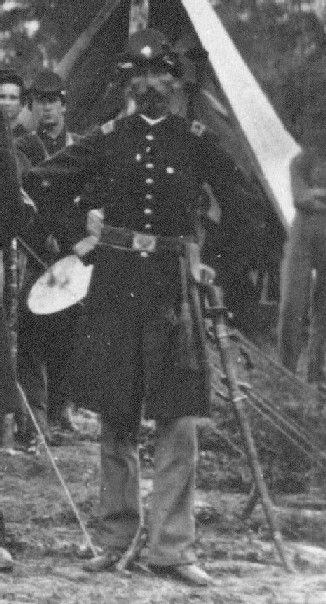 McAnally was born on 12th May 1836 in Co. Derry. During the Civil War he was a Lieutenant in Company D, 69th Pennsylvania Infantry, part of Gibbon’s 2nd Division. The Citation for his Medal of Honor reads that “In a hand_to_hand encounter with the enemy captured a flag, was wounded in the act, but continued on duty until he received a second wound.” He died in August 1905 in Washington. www.69thpa.co.uk/page11.html |
|
|
|
Post by groundhog on May 18, 2013 11:58:48 GMT
George Tyrrell
Resaca, Georgia
14h May 1864 Other than that he was born in Ireland and won the Medal of Honor little is known of George Tyrrell. He was a Corporal in Company H, 5th Ohio Infantry, later rising to First Sergeant. He earned the MOH at Resaca, Georgia on 14th May 1864 for capturing a flag, the medal being issued on 7th April 1865. |
|
|
|
Post by groundhog on May 18, 2013 12:29:00 GMT
Thomas Cosgrove
Drewry’s Bluff, Virginia
15th May 1864  Cosgrove was born in Co. Galway on 12th June 1829. He immigrated to the US in 1854 and during the American Civil War he served in Company F, 40th Massachusetts Infantry. Drury’s or Drewry’s Bluff overlooked the James river and was fortified as part of the defences of Richmond. It was attacked on a couple of occasions during the war but never fell to Union attack. The fortifications on the bluff were evacuated with the Confederate withdrawal from Petersburg and Richmond in 1865. During the attack in which Cosgrove won his MOH, Union troops captured some of the outer defences of Fort Darling on the bluff but a failure to reinforce led to their being driven out again. During the fighting Cosgrove single-handedly captured seven Confederate soldiers for which he was awarded the Medal of Honor on 7th November 1896. He died in Lexington, Massachusetts on 27th March 1912 and is buried in Munroe Cemetery. |
|
|
|
Post by groundhog on May 18, 2013 13:50:44 GMT
Patrick Leonard
Little Blue, Nebraska
15th May 1870 Patrick Leonard was born in Co. Meath on 19th May 1847. He served as a Sergeant in Company C, 2nd U.S. Cavalry. With four other men on 15th May 1870 he was searching for stray horses along the Little Blue river in Nebraska when they were were ambushed by a large party of Indians. The men fought off the attack and were awarde the Medal of Honor for Gallantry in action on 22nd June 1870. Leonard died on 1st January 1899 and was buried in Saint Joseph Cemetery, New Almelo, Kansas. |
|
|
|
Post by groundhog on Jun 14, 2013 23:43:38 GMT
Vicksburg, Mississippi
22nd May 1863 Several of our American Civil War Medal of Honor winners have fought around Vicksburg, Mississippi. The town controlled traffic along the river and it was vital that the Union Army capture Vicksburg if they hoped to split the Confederacy as Gen Ulysses Grant planned. The latest attempt at taking the town began in late April 1863 with a Union landing south of Vicksburg at Bruinsburg. Grant’s forces moved inland, pushing back Confederate forces near Jackson and securing Grant’s rear. There followed some fighting at Champion Hill and Big Black Bridge, pushing the army of Gen John Pemberton back into Vicksburg. Grant made two attempts to storm the town on 19th and 22nd May before settling in for a siege that ended with a Confederate surrender on July 4th. Seven Irish born soldiers won the Medal of Honor during the fighting on 22nd May. Patrick White  Patrick White was born in Sligo on 1st June 1832. His family emigrated during the famine and Patrick worked in a meat packing plant in Chicago while joining the Artillery Militia. He was commissioned a Lieutenant in the Chicago Mercantile Battery, Illinois Light Artillery after the outbreak of the war. During the attack on Vicksburg on 22nd May he led his battery in carrying its guns onto the Confederate defences in order to bring fire onto Rebel positions. He and the two other men who survived were awarded the Medal of Honor on 15th January 1895. White was taken prisoner by the Confederates in 1864 and spent a year in a POW Camp in Texas. He died on 25th November 1915 and is buried in Saint Agnes Cemetery, Menands, New York. www.taylorsbattery.org/PH%20whites%20sabre.htm Patrick McGuire Born in Ireland in 1840, McGuire was another member of the Chicago Mercantile Battery. He died in Evanston, Illinois on 8th September 1898 and is buried in Calvary Cemetery. Thomas Murphy  Born on 1st February 1844, Murphy served in Company I, 31st Illinois Infantry at Vicksburg. He voluntarily crossed the line of heavy fire of Union and Confederate forces, carrying a message to stop the firing of one Union regiment on another during the battle and was awarded the MOH on 14th August 1893 . He died on 31st December 1920 in Illinois and is buried in Green Valley Cemetery. John O'Dea  John O'Dea was a Private in Company D, 8th Missouri Infantry. At Vicksburg he ws one of 150 men who volunteered for a “Forlorn Hope” assault on the Confederate defences. They were quickly pinned down in the ditch they were to cross and were unable to retreat until nightfall. Of the 150 men in the storming party, nearly half were killed, the Seventy-nine survivors were awarded the Medal of Honor. O’Dea received his on 12th July 1894. He was born in Limerick in 1839 and died in Illinois in 1905. He is buried in Sunset Cemetery. www.geocities.ws/Infantry8thMO/BioODeaJ.html[/img] [/center] Menomen O'Donnell was aDonegal-man born on 20th April 1830. He emigrated in 1848 and working hard, financed the move of his family from Ireland to the USA. O’Donnell joined the Army in July 1861 and served as a Lieutenant in the 11th Missouri Infantry. Despite being on the staff he joined his regiment in the assault on Vicksburg on May 22nd. His medal was issued on 11th September 1897. O’Donnell died in Vincennes, Indiana on 4th September 1911 and he is buried in Mount Calvary Cemetery. irishamericancivilwar.com/2013/06/12/medal-of-honor-first-lieutenant-menomen-odonnell-11th-missouri-infantry/ William Toomer 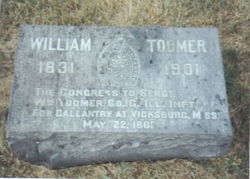 William Toomer was born on 12th January 1830 and died on 27th December 1901. During the Civil War he served as a Sergeant in 127th Illinois Infantry. His MOH was awarded on 9th July 1894 for gallantry in the charge of the "volunteer storming party” which means he was part of the Forlorn Hope. He is buried in Graceland Cemetery, Chicago. Edward Welsh  Also in the Forlorn Hope was Private Edward Welsh of the 54th Ohio Infantry. He was born on January 3rd 1843. His medal was issued on 11th May 1894. Welsh died on 1st February 1929 in Washington DC where he is buried in Mount Olivet Cemetery. |
|
|
|
Post by groundhog on Jun 16, 2013 20:08:38 GMT
Joseph Keele
North Anna River, Virginia
23rd May 1864
We’re back in Virginia where Grants Overland campaign continues after the fighting around Spotsylvania Courthouse. Lee has retreated south of the North Anna River and set up a defensive line. The Battle of North Anna, fought over two days on May 23rd and 24th 1864 was an attempt by Grant to cross the river and destroy the Confederate Army. Lee hoped to fight the Union Army piecemeal but failed to do so through illness, and the withdrawal by Grant as soon as he saw his forces in danger. www.civilwar.org/battlefields/north-anna.htmlJoseph Keele was a Sergeant Major in the 182nd New York Infantry Regiment, 4 Brigade, Second Division of Hancock’s II Corps at North Anna River. Hancock’s Corps advanced in the area of the Chesterfield Bridge crossing of the river, driving back a South Carolina Brigade commanded by Col. John W. Henagan and turfing them out of a small redoubt they had built north of the river. II Corps did not cross the river however because of heavy Confederate Artillery fire, but dug in on the north bank. Gibbon’s Second Division was located on the left flank near the railway bridge and it was here that Keele earned his Medal of Honor for “Voluntarily and at the risk of his life carrying orders to the brigade commander, which resulted in saving the works his regiment was defending”. His medal was issued on 25th October 1867. Joseph Keele was born on 1st August 1840. Later in the war he was commissioned and rose to the rank of Captain. He died in New Jersey on 16th October 1906 and is buried in Bayview-New York Bay Cemetery, Jersey City. Keele Photo- Findagrave |
|
|
|
Post by groundhog on Jun 16, 2013 20:26:45 GMT
Richard Barrett
Sycamore Canyon, Arizona
23rd May 1872  Richard Barrett was a Mayoman, born in 1838. He joined the army in Buffalo, New York and served in A Company, 1st Cavalry Regiment. In May 1872 he was a First Sergeant serving in Arizona. On 23 May 1872 he led a charge on some Tonto Apaches and was awarded the Medal of Honor on 12th April 1875 for “conspicuous gallantry”. He died on 20th March 1898 and is buried in the US Soldiers' and Airmen's Home National Cemetery, Washington DC. |
|
|
|
Post by groundhog on Jun 16, 2013 21:22:34 GMT
William Downey
Ashepoo River, South Carolina
24 May 1864 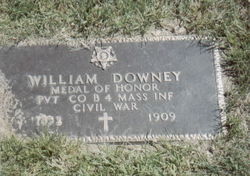 The 4th Massachusetts Cavalry was raised in late 1863 under Special Order No. 70 from the US War Department. Unusually the companies of the regiment served most of their time on separate assignments. Company B and D were posted to Hilton Head, South Carolina in April 1864. Initially the cavalrymen were employed on scouting and picquet duties. In late May however they participated in a disastrous expedition up the Ashepoo River, during which a steam transport, the Boston, was destroyed by Confederate artillery fire, killing 30 men and 74 horses. Four me of the 4th Massachusetts volunteered to rescue some of the survivors using a rowing boat and under Confederate fire. The four, two of whom were Irish, were eventually awarded the Medal of Honor, almost 35 years after the event. William Downey was a Private in Company B, 4th Massachusetts Cavalry (despite what it says on his headstone). He was born in Ireland in 1832. He died in New Bedford Massachusetts on 30th June 1909 and is buried in St. Mary’s Cemetery. Patrick Scanlan Born in Ireland in 1838, Patrick Scanlan was a Private in Company A. A bootmaker by trade he joined the army in Spencer, Massachusetts in December 1863. Scanlan or Scanlon on his gravestone, died in Farmington, Connecticut on 5th September 1903 aged 65. He is buried in St. Mary's Cemetery, Avon. |
|
|
|
Post by groundhog on Jun 20, 2013 8:38:08 GMT
Michael Murphy
North Anna River
24th May 1864  Meanwhile back at the North Anna River in Virginia, Hancock begins crossing the river at 8 am and during mid-morning II Corps began to push south. Gibbons Division crossed via a pontoon bridge and advanced along the axis of the railroad, pushing back Confederate skirmishers and then being held up by a combination of a Confederate earthwork and a thunderstorm. Despite reinforcements and several attacks, Gibbon could not break through the Confederate line. By evening Union High Command began to realise that they were marching their forces into a trap. The inverted V of the Confederate defences splitting the Union army into two wings with neither able to support the other, and with a river at their back. A halt was called and the Union army dug in. The following day, Grant ordered a withdrawal back across the river. In McIvors brigade of Gibbon’s division was the 170th New York infantry, commanded by Lieutenant Colonel Michael Murphy. Murphy was born in Kilmallock, Co. Limerick in 1836. During the fighting at the Confederate earthworks, the 170th New York, expended all its ammunition. Murphy kept his unit in the field under fire for three hours without being able to return fire. He was awarded the MOH on 15th January 1897. Michael Murphy died in New York on 4th March 1903, having served as a State Assemblyman and Senator, and having taken part in the Fenian raids on Canada. He is buried in Kensico Cemetery, Valhalla, New York. |
|
|
|
Post by groundhog on Jun 20, 2013 9:14:15 GMT
Patrick Shanahan
USS Alliance
28th May 1899  Patrick Shanahan was born in Ireland on 6th November 1867 and served in the US Navy. Aboard the USS Alliance on 28th May 1899, Chief Boatswain's Mate Patrick Shanahan rescued a shipmate, William Steven, from drowning. Shanahna was decorated with the Medal of Honor on 29th November 1899. Shanahan later rose to the rank of Lieutenant and died on 7th December 1937. He is buried in Arlington National Cemetery. There seems to be some confusion about wherhe won his medal. Some sources say it was a peacetime ward and some say it was awarded for actions during the Philippine Insurrection. As USS Alliance was part of the Atlantic Trining Squadron, I’d opt for the former. |
|
|
|
Post by groundhog on Jun 20, 2013 9:15:25 GMT
John King
USS Vicksburg
29th May 1901  John King was a holder of two Medals of Honor, the first of which was earned on 29th May 1901 during the Philippine Insurrection. He was born in Co. Mayo on 7th February 1865 and joined the US Navy in 1893. In 1901 he was a watertender on the USS Vicksburg. On 29th May 1901, Vicksburg suffered an boiler accident, during which King earned a MOH for heroism. His second MOH was earned aboard board the USS Salem, for extraordinary heroism during another boiler accident on 13th September 1909. King was discharged from the Navy in 1916 but rejoined again when the US entered WW1, serving ashore until 1919. He died in Hot Springs, Arkansas where he is buried in Calvary Cemetery, on 20th May 1938.
|
|
|
|
Post by groundhog on Jun 28, 2013 9:39:16 GMT
James O'Beirne
Fair Oaks, Virginia
31 May 1862  James Rowan O'Beirne was born on 25th September 1844 in Ballagh, Co. Roscommon. He joined the army on the outbreak of the Civil War and was commissioned into the 37th New York Volunteer Infantry in July 1861. On 31st May 1862 he was a Captain in his regiment at the Battle of Fair Oaks, Virginia when he earned the Medal of Honor. His medal citation says that he “Gallantly maintained the line of battle until ordered to fall back”. O'Beirne’s MOH was issued on 20th January 1891. Captain O'Beirne was wounded at Chancellorsville in May 1863 and discharged from the Army in June of that year on completion of his two years service. He was commissioned into the U.S. Veteran Reserve Corps on 24th July 1863 and worked his way through the commissioned ranks to Colonel and Provost Marshal of the District of Columbia. It was in this capacity that he took part in the hunt for and capture of Lincoln’s assassin, John Wilkes Booth. Promoted to Brigadier-General, James O'Beirne left the army for the final time in January 1866. He died in New York on 18th February 1917 and is buried in Woodside, NY. |
|
|
|
Post by groundhog on Jun 28, 2013 10:05:20 GMT
Santiago de Cuba
2nd June 1898 At the beginning of the Spanish-American War, the Spanish fleet was bottled up in the harbour of Santiago de Cuba, protected there by shore batteries. The US strategy was to keep them there until landforces took out the shore defences and the navy could then destroy the Spanish fleet. On the night of 2nd June 1898, eight volunteers sailed the USS Merrimac into Santiago de Cuba harbour with the intention of sinking her and thus blocking the harbour entrance. The ship was disabled by fire from the shore batteries and sunk by Spanish destroyers. The eight men aboard werecaptured and held as Prisoner of War until early July when Santiago de Cuba was captured by the US Navy. Two Irish-born sailors were among the eight men who were all decorated with the Medal of Honor. Daniel Montague  Montague was born on 22nd October 1867 in Wicklow. He was a Chief Master-at-Arms in the US Navy IN 1898. His medal was issued on 2nd November 1899 for “ in connection with the sinking of the U.S.S. Merrimac at the entrance to the harbor of Santiago de Cuba, 2 June 1898. Despite heavy fire from the Spanish batteries, Montague displayed extraordinary heroism throughout this operation”. Montague remained in the Navy until his death on 4th February 1912. He is buried in The United States Naval Academy Cemetery, Annapolis, Maryland. John Murphy  Murphy was born in 1869. His medal date and citation are the same as Montague’s. He served in the Navy until 1905 and died in San Diego, California on 9th April 1941. He is buried in Fort Rosecrans National Cemetery, San Diego.
|
|
|
|
Post by groundhog on Jun 28, 2013 11:18:12 GMT
David Casey
Cold Harbor, Virginia
3rd June 1864  David Casey was born in Ireland in 1842 and died in Massachusetts on 4th January 1893. During the Civil War he served as a Private in Company C, 25th Massachusetts Infantry. At Cold Harbor, Virginia on 3rd June 1864 his regiment was advancing on the Confederate lines. Two Colour Bearers were killed in quick succession, the last falling close to Confederate lines. Casey rushed forward under enemy fire rescuing the regimental colour. Casey was captured later in the war and was a POW. He returned to Northbridge Massachusetts where he is buried in Saint Patricks Cemetery.
|
|